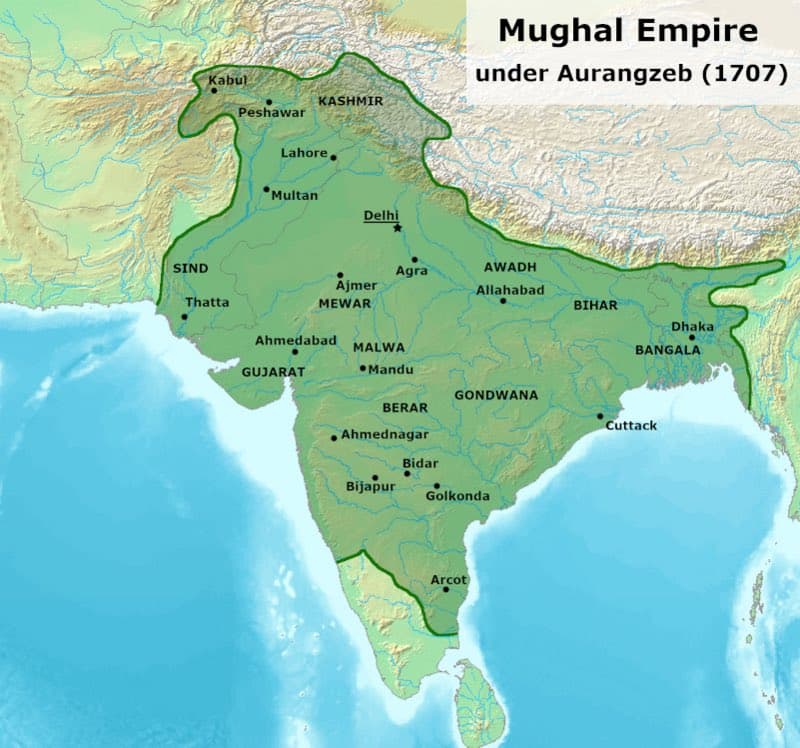Aurangzeb life…
MUHI- UD- DIN MUHAMMAD AURANGZEB ALAMGIR, commonly known as Aurangzeb, was the sixth Mughal Emperor, who ruled over most of the Indian subcontinent during the late 17th century. His reign was marked by a strong central authority and the expansion of the Mughal Empire to its greatest extent. Despite his military achievements, Aurangzeb’s policies towards religion and governance remain a topic of historical debate, shaping his controversial legacy in Indian history.
“Some say Hero, Some say foe, The truth of the emperor, Who will know?
A king of rules, a king of wars, His name still shines like distant starts”.

The sixth Mughal emperor
He was born on 3 November 1618 in Dahod, Gujarat in India. He ruled from 1658 to 1707.
EARLY LIFE:
He was the third son of SHAH JAHAN and MUMTAZ MAHAL. His siblings included DARA SHIKOH, SHAH SHUJA, MURAD BAKSH, JAHANARA BEGUM, and ROSHANARA BEGUM.
He was sixth Mughal ruler before him they are Babar, Humayu ,Akbar , Jahangir ,Shahjahan and the Aurangzeb.

RULE AND LEGACY:
- Became emperor in 1658 after imprisoning his father and defeating his brothers.
- Expanded the Mughal empire to its largest size but faced constant rebellions.
- Imposed strict Islamic policies, which caused unrest.
- Died on 3 march 1707 in Ahmednagar, aged 88.
- Buried in a simple grave in Khuldabad, Maharashtra , as per his wishes.
Who is Aurangzeb?
He used to earn his living by sewing hats, offered namaz in a small simple mosque, and had respect for women. Administration was entrusted to Hindu kings. During his era, the borders of India were vast, making it larger than contemporary China.
Territorial Expansion
Territorial Expansion: Under his era (1658–1707), the Mughal Empire expanded significantly, with its territory surpassing that of contemporary China.

Taxation Policies:
- JAZIYA AND ZAKAT TAX
He used to collect 1.25% JAZIYA TAX from Hindus and 2.5% Zakat tax from Muslims, with India alone contributing to 25% of the world’s GDP.
WEALTH CONTRIBUTION:
He had ten times more wealth than the greatest king of that time, LOUIS of France. The empire’s annual revenue was estimated to be around 38 crore, making the Mughal empire one of the richest worldwide. The empire controlled a large share of the world’s economy, mainly through textiles, spices, and handicrafts.
Inclusion of Hindu Nobles:
- Aurangzeb continued the Mughal tradition of appointing Hindus to high-ranking positions.
- At the peak of his rule, around 30% of his nobles were Hindus , with many holding influential roles.
- Notable Hindu nobles in his court included raja Jaswant Singh (Rajput), Raja Jai Singh I , and Raja Raghunath Rao.
- Aurangzeb employed Maratha officers and administrators, even as he waged war against Shivaji and later his successors.
Temples that are built by Aurangzeb
- Balaji Temple, Chitrakoot (Madhya Pradesh)
- Mahakali Temple, Chittorgarh (Rajasthan)
- Kashi vishwanath Temple, varanasi (Uttar Pradesh)
- Someshwarnaath Mahadev Mandir, Allahabad (Prayagraj) , (Uttar Pradesh)
- Umanand Mandir , Guwahati (Assam)
Most temples linked to Aurangzeb are due to destruction rather than construction, but there are instances where he allowed or tolerated temple renovations.
The Number of Hindus in the Army
During Shah Jahan’s reign, the number of Hindus in all the posts in the army and important positions in the court was 24 percent , while during the time of Aurangzeb it had increased to 33 percent.

Post-Mughal Wealth Transfer:
Much later, When the British came, the work of sending India’s wealth to England began. GDP kept decreasing. The whites are gone, they were replaced by brown sahibs. The Mughals settled in India and the movable and immovable property remained in the country, But the British sent a lot of wealth from India to their country. The Mughals never sold the country, they became part of this country
The British left, but the process of sending wealth abroad continues unabated. If not England, Switzerland, St. Kitts, Panama or the Cayman Islands will do.

Today’s media calls him great who ruled India for only 10-15 years! And abuses the great Aurangzeb , the king of kings, who ruled undivided India for 50 years!

NOA ykPPJ jxWbLWD hcZ RcFQZ NLI uTV
Перед началом работы стоит ознакомиться с возможностями хрумера, чтобы избежать ошибок.
hi